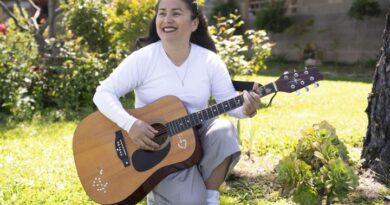A Brief History of Prison Pants

If a Central California Women’s Facility (CCWF) resident is wearing her pants backward, it means…
a) They got dressed in the dark;
b) They’re single and available;
c) The pants fit the same way, anyway;
d) They want to be different;
e) All of the above.
Any of these answers may be true, but if you chose b (single and available) or d (being different), you’re most likely to be correct. The way we wear our state clothing may reveal something about our lifestyle, preferences, or state of mind — even within the narrow mandate that we must wear stateissued blue pants.
Our “blues” style has evolved over time, but with no material improvement. Pre-2016, there were relaxed-fit almost-jeans made of a sturdy denim fabric and featuring practical pockets. For the Chowchilla summer (which heats up to 110 degrees), knee-length denim shorts were issued.
The jeans filled the requirement of “appropriateness,” and stood up to prison wear with yard-down time and physical-labor jobs. Shorts are the only humane option for when the sweat trickle starts as you’re waiting for a gate to open.
But as of 2016, that shred of dignity was snatched away as the facility switched to oversized, toddlerstyle, shapeless blues just heavy enough to bake your lower half three-quarters of the year. These were a hideous work of anti-fashion, featuring a too-narrow elastic waist which rendered them “one size fits none,” cutting into tummies and turning love handles into muffin tops.
Prison pants are constructed by incarcerated people under the supervision of the California Prison Industry Authority (CalPIA), a government agency that oversees more than 100 manufacturing and service industries inside our state prisons.
The 2016 pants are made of two identical cloth pieces stitched together and do not accommodate anything in the “trunk.” This could result in unintentional backside exposure, which directly contradicts our constant directives to “be appropriately dressed.” The only indicator that the pants are on backward is one small square pocket, perfectly designed for losing your ID, lip balm, or pens.
This iteration of CalPIA pants came in petite or tall sizes (tall only from size medium up), but those were as findable as an endangered species. This (tall) writer tried for years to obtain an extended-length small pant, with no luck. Otherwise, shorter or taller pants are not available onsite despite residents’ enormous height disparity, from under five feet to over six feet. The theoretical sizing offered on the website, from small to 7X-large, accommodates width, not so much length. Hello, flooding!
However, there is potential help for your tailoring needs. If your height or sizing falls outside of the available range, you can ask the Clothing Distribution Supervisor for an extension or hemming of your pants. According to DOM section 54060. 5.5, any nonmedical staff person can authorize clothing tailoring if it is deemed necessary for proper fit.
When you dehumanize and defeminize a group of women, what happens? People get creative to make their clothes fit better, which means alteration. If altering clothes is technically prohibited, then at least pant sizing must accommodate all shapes and body types. One popular fix alleviates pressure on the tummy: cutting the tight, narrow waistband and inserting extra elastic. Otherwise, the pants sit precariously below the roll. Stretch fabric is the minimum solution for sizing needs.
Most commentators trace the origins of today’s style of sagging to our very own prison system, where baggy uniforms and a prohibition on belts meant pants were riding low.
In 2023, residents heard that jeans were coming back, but were palpably disappointed by an essentially shapeless, trash-bag style, now with two longer front pockets. Props for the functional pockets. Meanwhile, the old-school denim jeans remain coveted. Some long-term residents still wear this sturdier style.
But, where are the shorts? Shorts were once again approved by California Department of Corrections before the summer of 2024, yet residents are still waiting.
Let’s look at pockets in more depth. For some unexplained reason, CCWF residents are not allowed to have pockets in their “grays,” or the attire worn on local yards. This means exercising on the yard with nowhere to put your ID, lip balm, water bottle, sunblock, shades, etc., except for tucked unceremoniously into a sports bra or rear waistband. Can you envision the inherent problems? Sweat, objects falling out of clothes, inappropriate digging into your bra on the yard.
Currently, a men’s baggy, gray jogger with one small side pocket is available through one of our quarterly prison vendors. Yes, one pocket. It’s weird to try to be casually comfortable standing with only one hand in a pocket.
And then there’s the saggin’. Sagging (wearing your pants low on the hips, exposing some undergarment or skin) has been present in counter-cultures for many decades. Sagging appeared in the anti-Vietnam War era of the 1960s when the “hippie” movement promoted peace, love, and hip-slung bell bottoms. Most commentators, however, trace the origins of today’s style of sagging to our very own prison system, where baggy uniforms and a prohibition on belts meant pants were riding low.
Sagging was widely popularized in the 1990s, particularly in the rap and hip-hop scenes. Marked by groundbreaking artists like M.C. Hammer and Missy Elliott, these music genres proliferated with talented Black artists, who also created their own expressions of identity through fashion. Many artists adopted variations on sagging — from The Beastie Boys’ low-riding to Kriss Kross, who sported their pants hip-slung and backward.
Also in the 1990s, Britney Spears was performing in shiny white pants slung low enough to show all of the abdomen plus the top of her thong. The low-n-casual attitude spread throughout California’s surf and skate culture of the 90s and persists today. Lowered waistbands went mainstream, and chain stores like The Gap Inc. started marketing low-rise and hip-slung jeans. By the early 2000s, the definition of “waistband” was forever changed in everything from soccer shorts to yoga pants.
People embraced sagging as a style statement, “to create a cultural space for themselves, to do their own thing,” said Medeon Dean, our own talented rap and performance artist. Dean, who had a rap artist identity outside, remembers “taking clothes and wearing them in a different way. We’d turn pockets around or put pockets where they’re not supposed to be. Some would wear four or five pairs of different colors, so you could see the different waistbands.”
Turning pants so the pockets are in front carries a different meaning in CCWF culture: that the wearer is available for potential relationships.
We must distinguish between “sexy sagging” — which shows off a fit performer’s low midriff — and the “raunchy” look with pants riding underneath the backside. This projects a don’t-care attitude and can show disregard for authority.
Here’s the thing about pants: You can issue a standard uniform, but women and transgender people automatically express their individuality with their vastly different shapes and sizes. You can make us wear the pants, but you can’t dictate how we wear them. Our residents have proven that even institutional pants can be a style statement.
Republished from Wall City, a new documentary arts magazine capturing life behind the walls of California’s prisons. Wall City publishes online at wallcitymagazine.org. Coming soon on Edovo.



